When I was six years old, I often found myself in the kitchen watching my mother cook up a storm for the family. It fascinated me how she would multi-task and be able to cook so many dishes in much less time. After cooking, she would look relaxed and not tired, even so, a bit happier than when she was cooking.
Since that day, my favorite place was the kitchen and learning how to cook from my mother. Cooking always made me feel happy and calm. I never realized this till I was in my late teens when I would be home alone trying out a new recipe that I watched on a cooking show with some beautiful jazz music playing in the background.
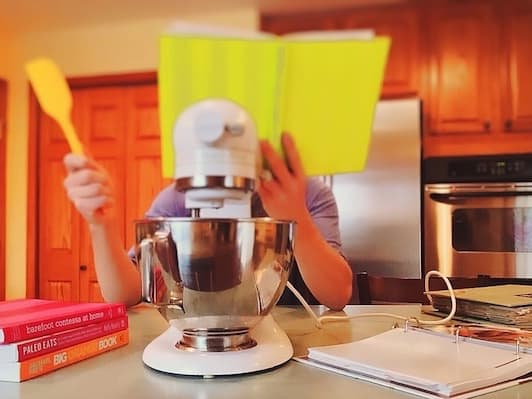
Soon, cooking for hobby became my passion. I would buy books and magazines related solely to food. Bouts of joy would fill my soul when I had to talk or read about food. The cherry on the cake was the launch of Masterchef Australia, a cooking show. I was hooked and booked by the show and never missed an episode. There was so much to learn from not only the celebrated chefs but from home-cooks as well.
I have discussed Benefits of Home Cooking in six parts in the article below for an easy understanding of the way they can be incorporated in our daily lives;
“Cooking is one of the strongest ceremonies for life. When recipes are put together, the kitchen is a chemical laboratory involving air, fire, water and the earth. This is what gives value to humans and elevates their spiritual qualities. If you take a frozen box and stick it in the microwave, you become connected to the factory. ” – Laura Esquivel
Is cooking like meditation?
For many of you, cooking might seem like a task, something you would not be interested in. Something that you feel takes up most of your time. But, for many Cooking is Meditation. It is soul therapy that just boils, steams and fries away all your stress. (It does that t for me all the time!)
Since we are living a fast-paced life, our food has also become fast-paced. We are not thinking mindfully when it comes to food. To catch up with the rat race, we have ignored and forgotten about the food we are feeding our bodies. We do not realize how the food we eat affects our bodies and the various benefits of home cooking.
Psychologists find that Cooking is Meditation
Importance of cooking at home
When I lived in New Zealand, studying and working for a couple of years, it was then I understood the importance of home-cooked meals.
Working part-time in an industry that had odd working hours, I found myself doing 12-16 hours shifts a day. My health deteriorated drastically since I never got the chance to eat my meals on time. Health-related ailments such as constipation, piles, headaches, acid reflux, insomnia, anxiety, restlessness and few others to name, dawned on me. It was a struggle that I overcame all of these only after I realized that all was mainly related to irregular food habits.
Therefore, I understood the benefits of home cooking, therefore I started deciding my meal plans in advance and rely only on home-cooked dishes. On my off days, I would brainstorm my menu for the week and cook it in bulk. This was of great benefit as I stopped skipping meals and also saved myself the anxiety of taking out time to shop and cook.
Benefits of Home cooking are not glaringly evident, therefore becoming less popular in modern times.
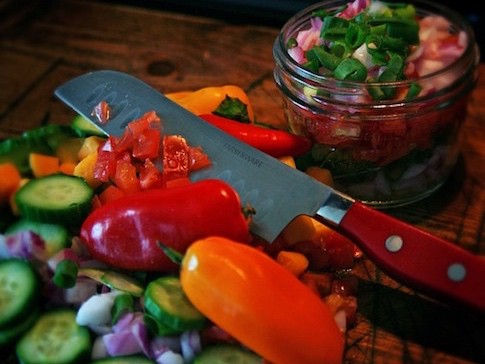
Did you know?
In 1900, only 2% of meals were eaten out and most families had dinner together. In comparison to in 2010, less than 33% of households shared meals more than twice per week and about 50% of American meals that year were eaten outside the home.
The benefits of cooking at home are numerous . I have listed down the advantages that you all will surely agree with once you understand the reasons behind them.
Benefits of Home Cooking:
I. Healthy Portion and Serving Size APT for your body
Eating enough falls in the top benefits of home cooking. To maintain a healthy weight it’s not only about what you eat – How much you eat is also equally important.
Do you have an idea of how much you should eat?
Can you understand the difference between serving and portion?
The information below will tell you the difference as well as tips to help you eat enough.
If you eat out of home – you have no control over the amount served to you – therefore the information is for beginners who aim at home-cooked meals.
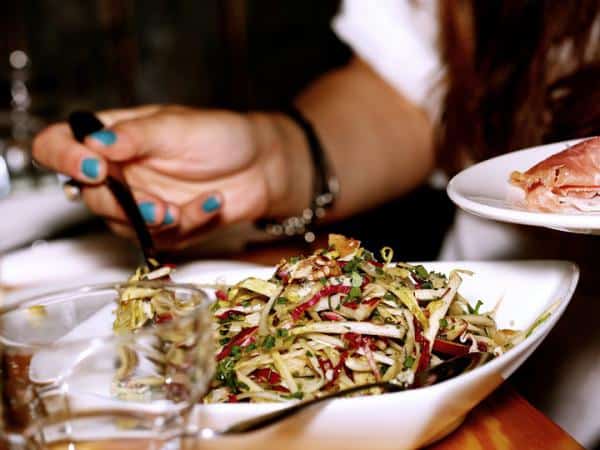
Portion:
Is the quantity of food you eat at one time or meal – be it at home, restaurant or a package. The portion size varies from the serving size – depending on how much you choose to eat.
Serving:
Is the quantity of the food as per the list on the food label or Nutrition Facts.
Serving sizes varies from product to product. Servings could be measured in pieces, slices, numbers, cups, grams or ounces. For example; two bananas. It is not necessary that the serving mentioned on the label is exactly how much you are to eat. It depends on your weight, gender, and lifestyle.
A container may have more than one serving – therefore check for the “servings per container.”
Home Cooking helps decide – How much should I eat?
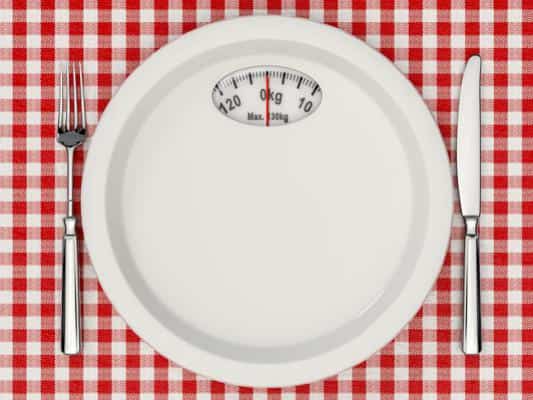
When you cook at home you can decide how many calories you need daily to lose, gain or maintain your current weight. It is based on your weight, age and metabolism, height, lifestyle, sex, and other factors.
When I was on a holiday during my Uni days – I would laze at home and just for a short walk once a week. However, now I run 4-5 times a week and I need more calories.
Dietary guidelines for 2015-2020 can give you a guideline as o how many calories you need. Based on the Body Weight Planner tool you can make your own physical activity plan and own calorie goal to achieve the weight you are targeting.
Other Nutritional facts to look out for on the labels are: fat, sodium, protein, saturated fat, trans fat, added sugars, Vitamin D, Vitamin C
Track how much you eat:

Other than tracking the servings – it is good to keep track of what, when and how much you eat then only you can understand the benefits of home food. This has a direct relation to food portions. You could download a food tracker or apps on your tab, mobile or calendar to record. The tracker tells you how much you eat versus how much physical activity are you indulging in.
Home cooking helps you manage food portions. I am sure none of us can think of measuring while eating or drinking all our lives. After having done this for a substantial time you tend to learn the portion or serving sizes.
Best Time to Eat – Breakfast, Lunch and Dinner as per Ayurveda
Cooking at home helps you decide portion sizes:
1. You know how much you want to eat and take that much on your plate. You could take one serving on your plate rather than eat out of the box which contains multiple servings.
2. Eat slowly and chew as many times as you can – because it takes 15 minutes for the brain to get the message that you have a full stomach.
3. Eat mindfully – almost as if you are meditating. Become aware of your senses – the smell, texture, and taste of the food in your mouth. Start enjoying every bite.
4. Make a resolution to never eat while watching TV or browsing the internet , working, walking or any other activity. When you eat – you only eat!
5. Eat tiny portions of food containing high calories – like sauces, desserts, frozen snack packets, fries. This habit won’t leave you craving for food you love to eat. You won’t end up feeling deprived of eating what you love most.
6. Eat regularly – at the time allocated. If you skip a meal – you may end up eating junk or overeat when you eat next.
7. While shopping – be mindful – check for packaged foods with minimal calories. Buy snacks like salads or fruits. In case you buy in bulk – divide them in single-serving packs before you store them. It is an easy method to avoid over-eating.
8. If you have leftover food – freeze it or share it with your friends or neighbors. This will make you feel good and also prevent you from trying to finish the large portion. Single – serving food packed in your refrigerator, will help you on those late nights when you are awake and don’t want to cook.
II. Home Cooking Saves money – How much and Why

One can actually save a lot of money by cooking at home. As a natural instinct, all of us are aware of the benefits of home cooking. By cooking at home – you can lose weight easily, eat balanced portions, bond with family or save money rather than eating out.
I have brought to you an analysis done by Forbes to find out the actual cost of cooking from scratch compared to eating out or eating from a meal kit service.
Analysis of Cost of Home Cooking Versus Restaurant food or Meal Kits
Forbes analyzed the data from “Priceonomics customer wellio”. Here they broke down 86 popular recipes for dinner and looked at the average cost per serving – if you cook them from scratch. Then it is compared to the cost per serving if you order from a restaurant or eat from a meal kit delivery.
You will be astounded to know that they found that “it is almost five times more expensive to order delivery from a restaurant than it is to cook at home.” In the case of a meal kit service, it is “almost three times as expensive as cooking from scratch.”
The average cost of meals
To make it simple – look at the chart below to see the average costs of the meals – comparing them based on where they came from – home from scratch, eating at the restaurant of meal kits.
Cooking at home is certainly time-consuming – however its a healthier option as you know and can decide what goes in your food. You can control the portion and serving size as per your body weight and lifestyle.
Forbes also looked at the cost of getting meals home delivered versus cooking at home from scratch. The prices mentioned are taken from websites of restaurants with national chains. This tells you which meals are most expensive when ordered. Take a look:
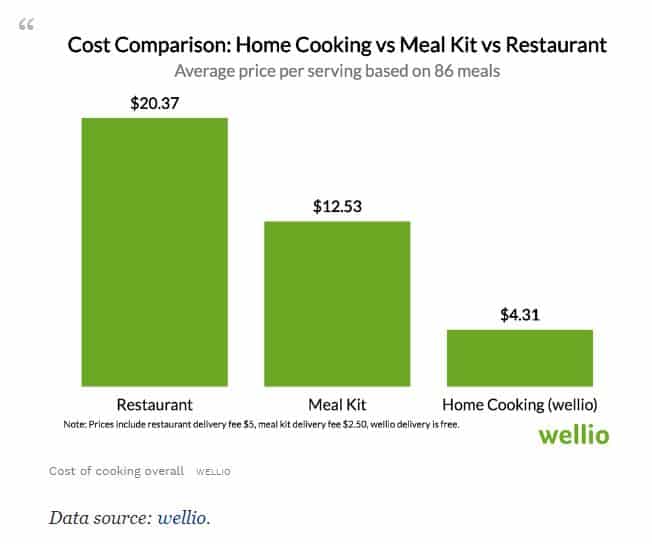
Date Source: www.forbes.com
It can easily be analyzed by looking at the above chart that meals that contain beef, chicken, and pork make you spend the most amount of the money. The delivery cost itself is $20 – $30 per person.
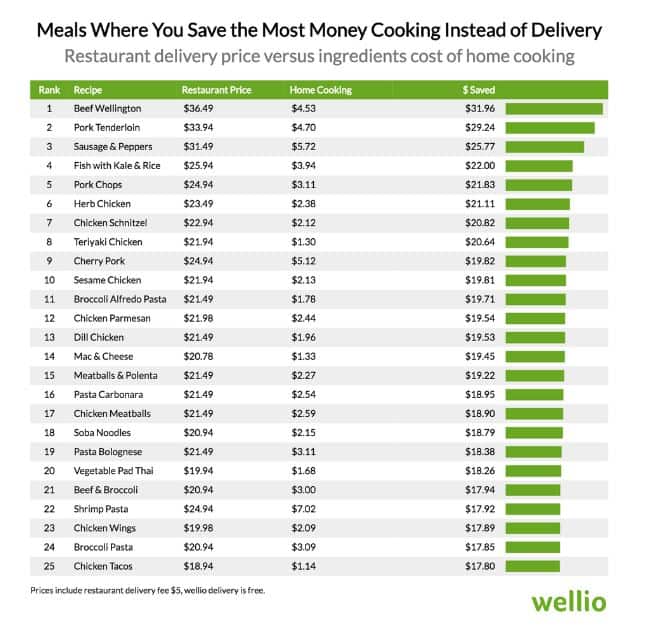
Date Source: www.forbes.com
Meal kits are another alternative to home cooking. The kits are pre-portioned and pre-assembled. You should avoid meal kits if you are ordering meat-based meals. Here is your chance to save money. Order for ingredients like pasta, cheese, flour from the grocery store to save substantial money. However, if you want to order a Chicken curry with a lot of ingredients and spices – call for a meal kit.
Always remember, cooking at home is time-consuming. However, you get a meal of your choice full of nutrients for $4 per person approximately.
III. Meal Planning Benefits Home Cooking:
Plan your menu several days/weeks ahead to avail the true benefits of home cooking. This will make you feel less tempted to eat something from out if you already have a curated planned and prepared menu ahead. You could also prepare a grocery list and make sure you stick to it to avoid buying extra food. (Definitely the hardest part because who doesn’t love grocery shopping!)

Tips on meal Planning:
i) Start weekly plans:
Plan for a week to begin with. Plan seven meals and avoid anything elaborate on days you get late from work or you go to the gym or for yoga classes. I would recommend that you plan dinner only to begin with and then graduate into breakfast and lunches as well. Decide the meals as per days of the week based on how much time you will have at the end of the day to assemble, serve and eat the pre-cooked food together.
Remember, to check out for any forthcoming bank holidays, travel plans, birthdays or anniversaries you may have to go out for. Also, keep in mind if you are anticipating guests or visitors over the weekend. If you aren’t sure – don’t hesitate to call and ask if your sister plans to come for a sleepover the coming weekend with her two kids and a dog.
ii) Always store staple food items at home:
This comes automatically to all of us as we plan our meals in advance. Soon you will notice that there are using the same items of food regularly.
If it is money saving that you are looking at – lookout for those big sale days or go to pick up stock at Costco at a wholesale price.

iii) Have room to store:
Invest in a deep freezer and boxes you can store. These could be stored as one serving per box. you could use re-heatable boxes to save dishwashing and time.
iv) Avoid Wasting Food:
If you use half a broccoli on the first day – use it for some other preparation the next day. group the ingredients to your meal plan – and you will end up wasting less and less. If you don’t want to eat broccoli again – make a larger dish in which broccoli is used and freeze it for the day you will get late to cook.
v) Use recipe Apps:
Have you ever heard of recipe Apps? yes, these apps help you save recipes from any browser and you could make your list f ingredients based on the recipes saved there. Some recipe apps also give you a list of ingredients to make it smoother for you know what to buy. Isn’t that so easy-peasy!
For beginners – meal planning may sound daunting. However, once you get into the rhythm it will come to you on auto-pilot. Never follow someone else’s staple list – because what you like and cook is a very personal choice. The more you plan your meals the more your life will become hassle-free.
IV. Cooking at Home makes you eat healthier – Why?
http://wordpress-334546-1028402.cloudwaysapps.com/what-is-mindful-eating-wellnessworks/
In 2014 a study was conducted by researchers Sara Bleich and Julia Wolfson and published in the journal Public health Nutrition. They studied how the overall diet of a person gets affected by cooking at home.
As per a survey of national health and nutrition, they examined data of two years belonging to people who cooked at least 6-7 times a week. Therefore, they found that these people who cooked at home ate lesser calories. The difference was approximately 150 calories. The ones who did home cooking – ate less fat and sugar, more fiber and fewer carbohydrates.
The most interesting part of the study is that the choices of healthier food were seen even if they were eating out.
As per a study conducted by Johns Hopkins Bloomberg School of Public Health Research:
“People who frequently cook meals at home eat healthier and consume fewer calories than those who cook less.”
Julia A. Wolfson, MPP, a CLF-Learner fellow at the Johns Hopkins Center for Livable Future and lead author of the study says:
“When people cook most of their meals at home, they consume fewer carbohydrates, less sugar and less fat than those who cook less or not at all – even if they are not trying to lose weight.”
Nutritional Programs that Include Cooking:

With this kind of finding it will not be surprising that instead of medicines soon doctors will start teaching you how to cook a healthy meal as a treatment.
The value of nutrition programs including cooking instruction is seen to be on the rise. With the help of these programs people are adhering to healthier diets, have healthy body weight, and eating appropriate portions of food.
The programs have brought noticeable changes in Type 2 diabetes patients, help them lower blood sugars and blood pressure.
Not everyone can cook – therefore for those who don’t understand what grocery to buy – home cooking instructions come in handy to boost the confidence. This soon converts into healthier eating habits due to better food cooking skills.
Mind Eating Tips for Weight Loss
Gaining knowledge on what are Healthy Ingredients
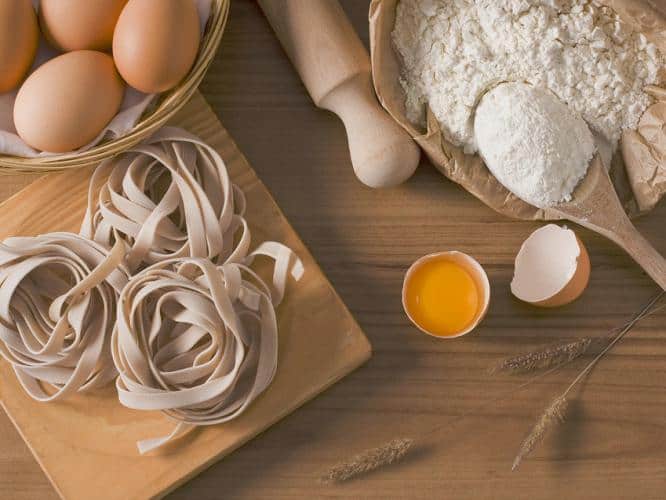
To understand the benefits of home cooking, the knowledge of what is healthy is the first step. Many commercially prepared dishes are high in chemical additives, fat, salt, and sugar. Thus, when you prepare your own food, you know exactly which ingredients and the exact amount of it goes into your food.
For example, when you make pasta at home you use fewer preservatives as the sauces are fresh and homemade with fewer ingredients.
The same goes for salad dressing. Instead of buying a bottled dressing, learning to make simple mustard, olive oil, and vinegar sauce from scratch that takes not more than five minutes flat. Usually, the bottled sauces or dressings contain a huge amount of preservatives and sugar that is very harmful to your body. Trust me, making your own sauce at home is not only fun but a learning process.
V. Bulk Cooking saves Huge Time
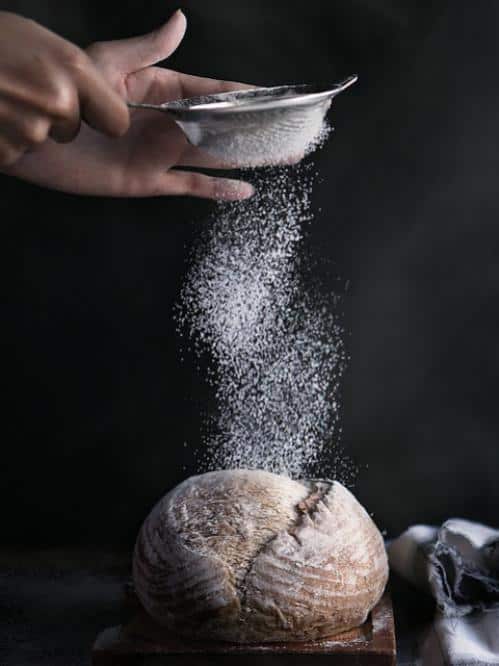
One of the biggest benefits of home cooking is; you get to cook in bulk so that it prevents waste, saves both money and time, and makes life pretty organized and anxiety-free. You don’t spend precious office time thinking about what to eat and what to prepare or fret because you worked late and may not get time to eat.
The factors you need to keep into consideration while cooking in Bulk are:
i) Plan in Advance to Prepare:
First and foremost you need to think and decide on which meals and for how many meals do you want to cook. Do you want to prepare all meals or only weekday dinners, or lunches and dinners both? It is a personal decision and there is no right or wrong about it. You decide as per what suits your lifestyle and family members.
ii) Time to be allotted:
Once you have figured out which meals and how many days of the week or month you want to prepare for, you list making starts. First, you decide on staples, then recipes and ingredients matching to those. Having listed them you go grocery shopping and store or refrigerate them. All of this could take a few days depending on how many meals you are going to prepare for. Remember if you are buying for the month – there are some ingredients like tofu that may not last a month.

iii) Plan and Buy as per Resources:
Since most of you are paid monthly salaries – it is best to plan the shopping as per the availability of money to purchase. You could use coupons, or go on sale dates if you are looking at saving some extra bucks. Loo out for manufacturer coupon deals.
Choose meals with similar ingredients so that you end up wasting as little as possible. For instance, if you are buying lettuce for a salad, you could also make a burger and use lettuce rather than wasting the leftover. Or for example: If you only need half a can of tinned black beans for the tacos you plan to use the rest for soups or burritos. Plan your recipes based on similar ingredients to avoid wastage and save cost.
iv) Cook Thematically:
Look at your recipes and see which are the common ingredients and take them out one by one. For example, say potatoes can be used for mashed potatoes as a side dish, potato wedges with burgers, potato fries as finger food, potato chickpea salad, and potato chickpea patties. Therefore, you can cook them altogether – fries can go in the air-fryer, wedges can go in the bake, pot to boil can go on the stove and so on and so forth.
If you are cooking carrots – make different dishes out of carrot so that you can either chop, boil, saute, grate or bake them before you freeze them. You could also make a lot of meals with one basic ingredient.
v) Use Flash Freezing techniques:
When you freeze stuff together they tend to stick to each other and difficult to thaw when you take them out of the freezer at a later date. Say for instance: you have to freeze chicken drumsticks, corn sticks as well as fries all to be eaten on the same day. Keep them all spread out on an open tray and freeze them. Once frozen you can stack them together and freeze them in a box or packet together to save time looking for them and save storing space.
There are many hacks available on Videos to freeze stuff creatively. Use ice trays to stock and freeze curry paste, pasta or pizza sauce, or soup stocks.
vi) Mark the items as per their use:
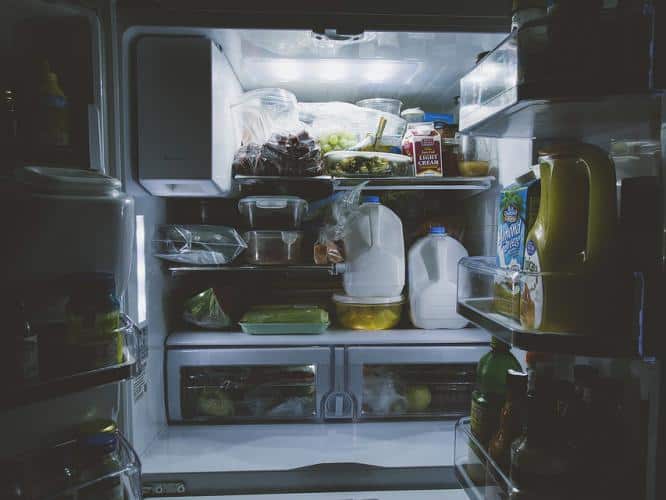
Take a masking tape or a permanent marker to write what is where. You could also do smaller packets and put them all in one big packet per day to make life simpler for you. This also helps when you cook and leave for work and someone else in the family has to take it out of the freezer. In case you traveling you could also write the name of the dish on the packet so that it is easy to recognize which packet to pull out of the freezer or cheese tray.
In our busy lives, we could easily forget which meal you cooked – thus, you could pin up your weekly or monthly meal plan so that you know what you are looking for when you open the fridge.
vii) Let Your Creative Juices Flow – Use leftover to make a new dish:
You can use leftovers by using your imagination. Leftover lamb chops can be shredded and filled in a hot sandwich for breakfast or that evening snack you crave for. Potato fries or wedges eaten with ‘beef burgers’ if get leftover can be used to make ‘Honey Chili Potatoes’ as finger food or eaten with fish – as Fish and Chips or just tossed in BBQ sauce or sprinkled with chili flakes and baked with cheese on top.
VI. Prevents Allergic Reactions
Food items that cause allergies are called allergens. One of the hugest benefits of home cooking is that you get to choose what you cook for whom and are sure that allergies of any kind can be avoided.
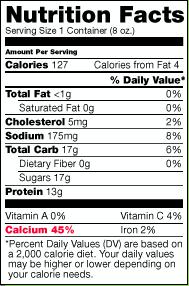
Home cooking gives you the opportunity to make your kitchen a trouble-free zone. The risk of allergens getting mixed up in your food will not be there if you follow these tips:
i) Read the Labels carefully while shopping:
While buying packaged food read the labels carefully as they have a list of the ingredients or a “contains statement”. Check it out for items that you or your child may be allergic to.
ii) Label and store items separately in the pantry:
You may not be the only one using the kitchen in your home. Therefore, it is advisable to label the food items as ‘Safe’ or ‘unsafe’ before you even keep them on the shelves. Best is to use ‘green’ color for safe items and ‘red’ for unsafe items as the brain reads these signals easily and no one can miss them.
You could easily use different shelves for unsafe food items and make sure the containers are properly sealed.
iii) Precautions in the kitchen:

The allergy triggers get into other food – sometimes by as simple a task as using the same utensil.
1. To avoid getting Allergenic Residue all over the house – Wash your hands before and after you prepare the meal. Don’t just rinse them with water or use antibacterial gel – instead, wash them properly with soap and warm water.
2. Thoroughly scrub and clean counters and chopping boards or any other surface you may use to cook at home. Peanut allergies are known to be very dangerous- therefore if someone has it at home – spray or sanitize the surface apart from just using regular dishwashing liquid. Don’t reuse the dishes after having cooked them – keep them instantly in the dishwasher or sink full of water.
3. If you can and have the space and resources to do so – you can use separate utensils to cook the items that can trigger allergies.
4. Don’t feel shy when someone is coming over for a meal at your home for the first time – if they are allergic to anything. They will respect you for your forethought and sensitivity.
5. Do you know that some people have such a high risk of allergens that even the vapor in the air where you have cooked can cause triggers? These are rare cases – however, in case of such cases – be extremely careful. Keep such a person out of the kitchen while cooking and after at least 30 minutes of cooking (it could be difficult for cases where you have an open kitchen).
6. Allergens spread fast due to their crumbs or vapor that are not visible to the naked eye. Make a habit of eating anything in the kitchen so that there is no fear or risk of spreading these allergens in other parts of the home. The allergens can easily travel through toys, carpets, upholstery, etc.
Note: You are not the only one who uses the kitchen at home. Thus, your family members also need to be educated about all of these above precautions.
iv) Suggestions on what to cook:
With so many people with food allergies, there is a substantial rise in allergy-friendly recipes – found online easily.
If you want to cook a recipe that has allergens in them – you should use alternates or substitute food items to adapt to your needs.
For example, you can substitute dairy-free oil in place of cheese. You could use applesauce in place of eggs, or ground cornmeal in place of breadcrumbs.
Whole Foods:
Look out for recipes that don’t have the need for substitutes as they are ‘whole foods’. For example, vegetables, fresh fruits, local proteins fall into whole foods. You should try and venture into the farmer’s market or the specialty food store rather than the local grocery store. If you use recipes using whole foods – it becomes easier as it reduces your need to look for substitutes.
VII) Cooking at Home creates Memories and Bonds
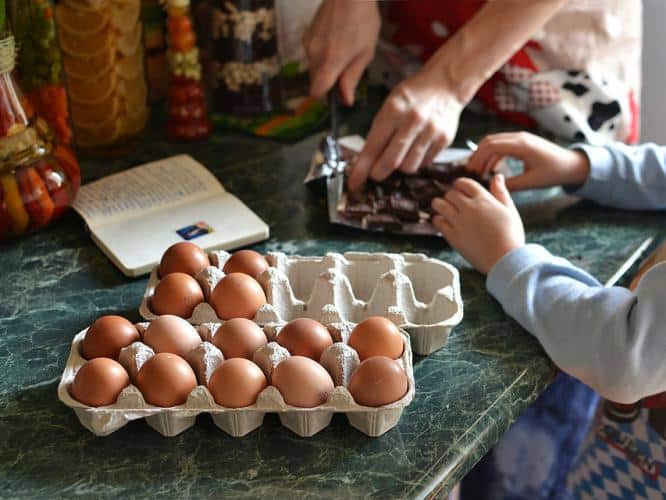
Studies show that when we eat together, our family is much healthier and happier. Eating together leads to less obesity, kids excelling in school, and less substance abuse within the family. It can help to ward off loneliness especially if you are in a new city or country and looking to make new friends.
Tips on Cooking to Create Memories and Bonds:
Some parents do not let the kids enter the kitchen because they fear that it will get messier and slow down the cooking process. However, if you look at the benefits of home cooking to deepen family ties and create beautiful memories – you will throw caution to the winds. Adding in those 15 extra minutes to clean the kitchen is totally worth it end of the day.
Therefore, keep a meal or two on a specified day of the week or month when all of you cook together. Make it look like teamwork that is playing a game – assign roles to each as per their caliber and age. Give the task of stirring dishes on the pot, or setting the timer for the bake, taking out the ingredients from the refrigerator that are easy and non-skill tasks to the ones who are beginners.
One of the earliest and most pleasant memories of childhood days is remembering the fun times in the kitchen spent with their parents pottering around.
Kids gain Food Knowledge and Soft Skills:
It’s fun to see kids try their hands at something new. Introducing them to the smells, sounds, textures, names, and sight of food items will make them understand what is it that they are served on their plates. As a result, their knowledge of food increases. When they start helping or cooking they start appreciating the efforts made by their parents to put a meal together.
Benefits of Home Cooking on Kids:
- How to work in a team, have patience and do things systematically
- Start recognizing the labels and ingredients – thus their interest in home-cooked food increases
- To manage temperatures and operating gadgets
- Learn to read and translate recipes into dishes
- Skills like chopping, grating, kneading, mincing, mixing, peeling, cracking an egg, slicing becomes their second nature
- The chemical reaction – what goes into what dish and which spice goes at what stage while cooking
- Kids recognize the aromas and sounds of sizzle or roast associated with cooking
- How to clean up and leave the kitchen spic and span
Kids with more know-how about food items always have a smoother transition when they go for Uni and start cooking on their own. This is because they do not have apprehensions about going into unknown territories. Cooking is like learning to swim – once you learn you can never forget it.
Cooking together with family becomes more of a fun activity and incorporates healthy eating habits as well especially among children. Involve them in food preparation by asking them to read the recipe out loud or mixing the easy ingredients. (My grandmother would always make all her grandchildren sit around her to help her prepare Christmas goodies. It was always fun and jolly.)
Having a potluck with friends can reap many of the same benefits as well.

Advantages of cooking at home
Do you remember that time when your mother would prepare scrumptious meals and you would wait eagerly for lunch or dinner? I would always wait for the big Sunday feast after church that my mother would lovingly prepare for the entire family. It would either be a Shepherd’s pie or Lamb roast with lots of steamed vegetables and baked potatoes. I am salivating already! Yum!
However, as we grew up, concentrating on our goals and dreams, we forgot the importance of home-cooked food and chose to gulp down processed food from McDonald’s, Pizza Hut, KFC and many other fast food joints.
“When we eat at a restaurant, we pay for not only the food but also the costs of running that business. The lights, the water, the building, and the staff — in addition to the meal we are eating. The same goes for pre-made or frozen meals at the grocery stores.” – Ben Atkinson, a dietitian at Harborview Medical Center, Seattle, USA.
30-minute meal Ideas – A solution to Home Cooking
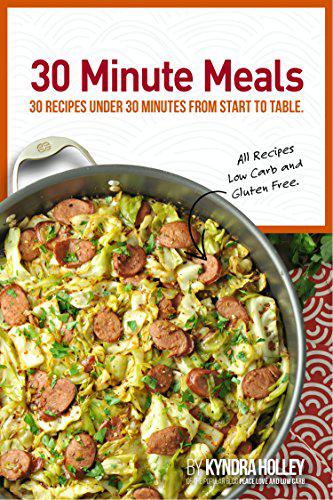 There are numerous websites and channels that provide recipes of all kinds from complex to easy to under 30-minutes meal ideas – as benefits of home cooking for beginners.
There are numerous websites and channels that provide recipes of all kinds from complex to easy to under 30-minutes meal ideas – as benefits of home cooking for beginners.
For example – Food Network, a lifestyle network, website, and magazines based in the USA that provides content that brings joy to its viewers through food. This network offers cooking recipes and cooking shows lead by celebrated chefs and food experts.
Many times, I find recipes to cook from this website or watch cooking shows when I want to learn something new.
This website offers 30-minute meals that are not only delicious but healthy as well. Some of my favorites are the Deviled Chicken Francese and Korean Sloppy Joes by Rachael Ray and the Peanut butter and Jelly Pancakes by Sandra Lee.
There are many other such websites besides Food Network that I love scrolling through such as Joy of Baking (Youtube Channel) for a collection of desserts, Allrecipes, Yummly, EatingWell for healthy recipes and many others to name a few.
Why We Need to Rethink Home-Cooked Meals
CONCLUSION
Home cooking not only connects with your body but your soul is enlightened to a point that food becomes an important aspect of your life not just to survive but to appreciate the importance of every ingredient.
When you start working towards the benefits of home cooking – they lead to eating healthy food that can become a habit in the near future.
Cooking is not work, it’s recreation!









